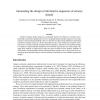Free Online Productivity Tools
i2Speak
i2Symbol
i2OCR
iTex2Img
iWeb2Print
iWeb2Shot
i2Type
iPdf2Split
iPdf2Merge
i2Bopomofo
i2Arabic
i2Style
i2Image
i2PDF
iLatex2Rtf
Sci2ools
JCNS
2011
2011
Automating the design of informative sequences of sensory stimuli
Adaptive stimulus design methods can potentially improve the efficiency of sensory neurophysiology experiments significantly; however, designing optimal stimulus sequences in real time remains a serious technical challenge. Here we describe two approximate methods for generating informative stimulus sequences: the first approach provides a fast method for scoring the informativeness of a batch of specific potential stimulus sequences, while the second method attempts to compute an optimal stimulus distribution from which the experimenter may easily sample. We apply these methods to single-neuron spike train data recorded from the auditory midbrain of zebra finches, and demonstrate that the resulting stimulus sequences do in fact provide more information about neuronal tuning in a shorter amount of time than do more standard experimental designs.
Related Content
| Added | 14 May 2011 |
| Updated | 14 May 2011 |
| Type | Journal |
| Year | 2011 |
| Where | JCNS |
| Authors | Jeremy Lewi, David M. Schneider, Sarah M. N. Woolley, Liam Paninski |
Comments (0)

